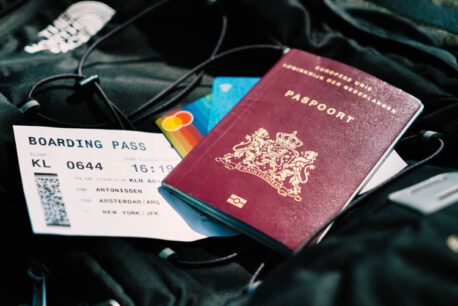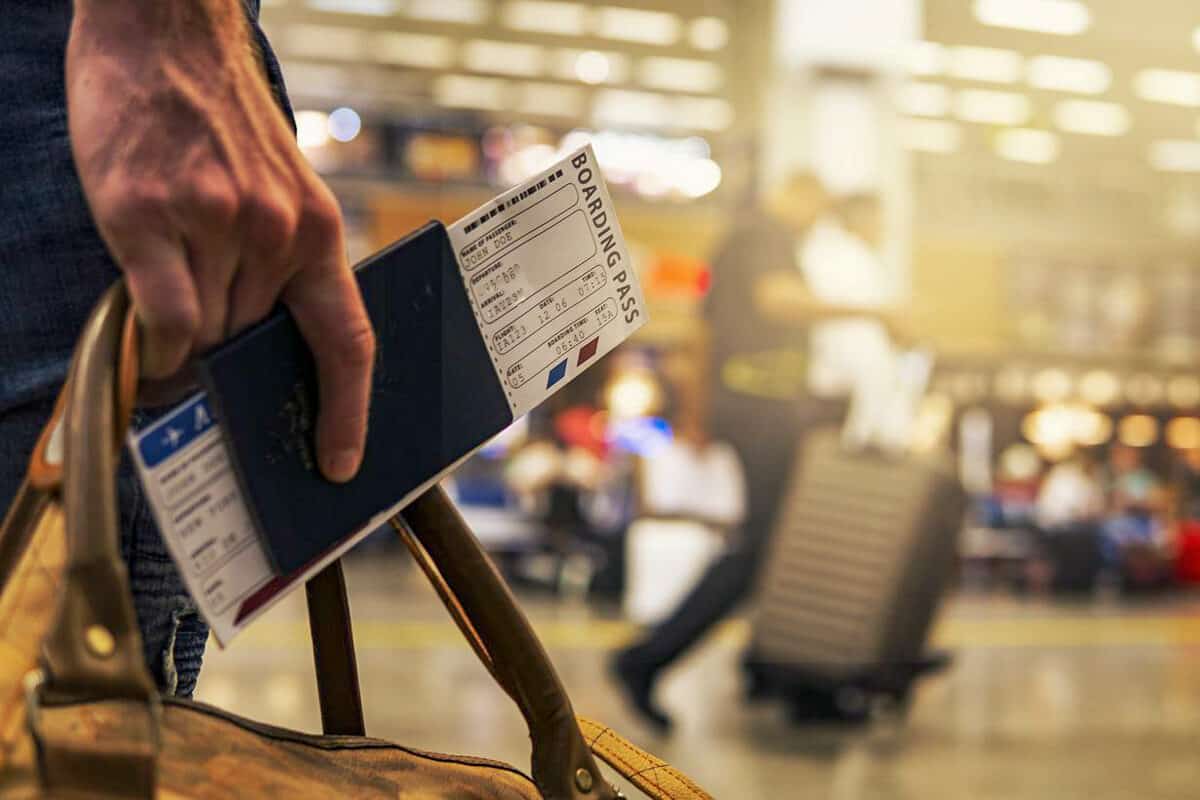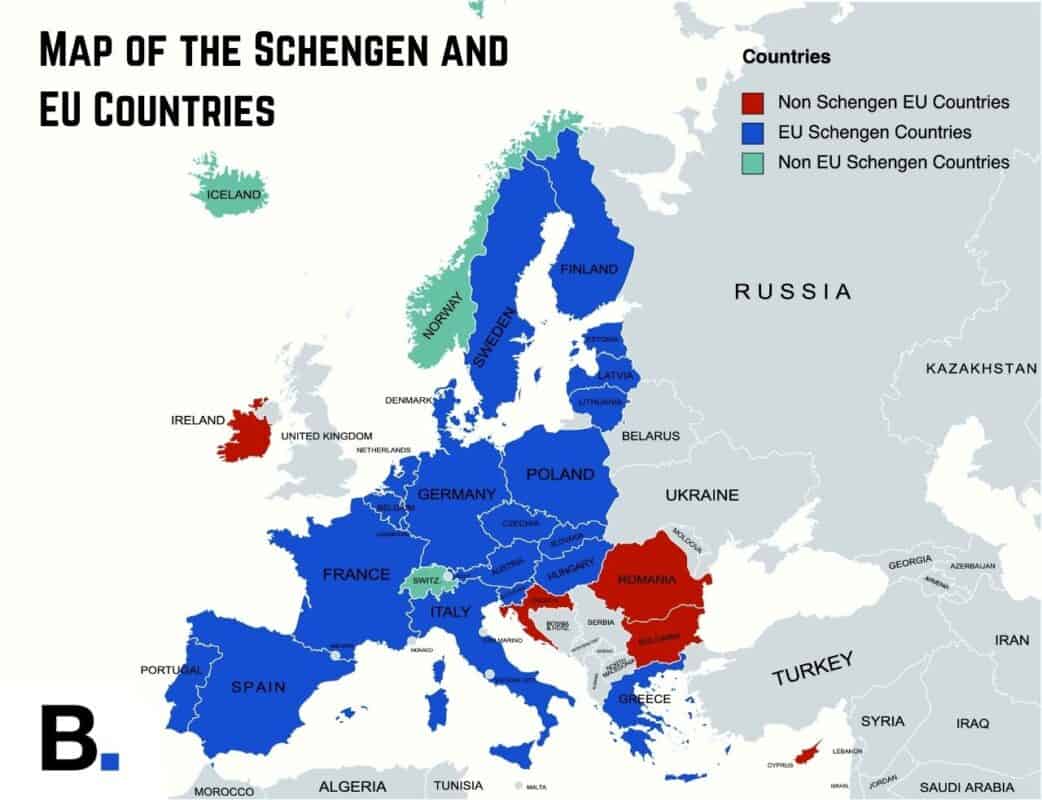Driving in Europe checklist
There are a number of requirements you might not be aware for when driving in Europe, so it’s worth downloading our checklist, as well as reading this guide carefully to find out everything you need to drive in Europe.
We also recommend purchasing a European driving kit as they can prove essential in some countries where it is the law to carry additional items in your car.
European driving checklist
This essential checklist will tell you everything you need to know for driving in Europe, from what to take with you to things to remember when you get there.
Important documents for driving in Europe
- Full, valid driving licence and national insurance number
- Proof of vehicle insurance
- Proof of ID (passport)
- V5C certificate (the ‘log book’)
- Travel insurance documents
- European Breakdown Cover policy number and documents
- Before you travel ensure your vehicle’s tax and MOT are valid and up-to-date
- Crit’air sticker if driving in France (find out if you need one here)
You may also need to carry other documents with you, namely:
- one or more international driving permits
- a separate UK sticker
Required equipment for driving in Europe
- Reflective jackets (there must be one for each passenger and be kept within the cabin of the car)
- Warning triangle (compulsory in most countries)
- Headlamp beam deflectors (depending on your car, you’ll either need deflector stickers or have to adjust the beam manually)
- Safety helmets are compulsory for riders and passengers of motorcyclists and moped users
- UK car sticker (if you don’t have a GB Euro number plate, or no matter what’s on you number plate when driving in Cyprus, Malta or Spain)
- First aid kit (compulsory in Austria, France and Germany)
Recommended things to take with you for Driving in Europe
- Fire extinguisher
- Replacement bulbs
- A high quality torch
- A spare fuel can
- Additional engine oil and water (for topping up)
- An up-to-date road map or satellite navigation system
- Blanket
- Sun cream
- Refreshments and plenty of water
- If you have children, take some games you can play in the car during the journey
- Take extra supplies of medication in case you can’t get these abroad
- Photocopies of important documents
- European Health Insurance card
European Breakdown Cover
Get covered when driving in Europe from less than £5.79 per day.*
Downloadable driving in Europe checklist
For a comprehensive list of what you need to take with you when driving in Europe with a UK car, our downloadable checklist will have you fully prepared.
In addition to the checklist above, the next best thing to do is to familiarise yourself with the driving laws, specific entry requirements and compulsory items to carry for the country/ies you will be driving in.
You can find everything you need to know on our detailed European countries advice pages below.
If the country you are visiting is not on the list use the ‘driving advice for every country in Europe’ widget to your right (at the bottom of the article on mobile) to find the right country.
For those travelling to France we also have a further top ten tips for driving through France to keep your knowledge up to date at a glance.
Will Brexit impact my European travel plans?
There is inevitably a degree of uncertainty, but don’t let this put you off driving abroad.
Based on government advice, we recommend that you spend a little extra on an International Driving Permit if you’re planning on driving in Europe. It’s better to be safe than sorry.
The RAC will continue to provide breakdown cover through our partners operating within the European Union.
With our European breakdown cover, there is no limit to the costs to get your vehicle home, whether you’re travelling to Europe for a single trip or all throughout the year.
If repairs cost more than £500 you can choose to have your car brought home instead of having it repaired in Europe, providing the vehicle is not beyond economical repair.
It is vital that you also have the correct documentation with you – such as an International Driving Permit.
Do I need an insurance green card?
From 2nd August 2021, drivers will no longer require an insurance green card for taking their vehicles to an EU country.
20 tips for driving in Europe: before you leave

We’ve teamed up with the Foreign and Commonwealth Office (FCO) to give you some tips on preparing for a great trip, whether you’re driving or travelling abroad.
1. Adjust your headlights
It is a legal requirement not to dazzle oncoming drivers.
Make sure you adjust your headlamps ready for driving on the right-hand side of the road.
Headlamp converters (stickers you put on your headlights) are widely available.
2. Buy a UK sticker
Don’t forget that your vehicle must display the appropriate country identification letters (e.g. UK).
Failure to do so may result in an on-the-spot fine, but if your number plates include the UK Euro symbol, you do not need a sticker within the EU (except in Cyprus, Malta and Spain, where stickers are needed no matter what is shown on your number plate).
3. Make a travel pack
Create a travel pack containing all the appropriate documentation you will need to comply with the legal requirements of the country you are visiting and to help if you get into difficulties.
In addition to your passport and driving licence this may include your vehicle registration document (V5); motor insurance certificate; International Driving Permit (if required or advised); breakdown policy and contact numbers; travel insurance documents, and any emergency helpline numbers.
Buy a European Driving Kit from £20.99
Don’t get stung with fines abroad for not having a European Driving Kit
4. Check your breakdown cover extends to Europe
You may need to increase your existing cover or take out standalone European breakdown policy to avoid unnecessary stress and significant additional expense if anything goes wrong.
If you need breakdown cover abroad for a short time, why not try our Single Trip European Breakdown Cover, starting from just £6. If you drive to Europe on a regular basis, then our annual trip product will be more suitable for you.
5. Check your car insurance
Make sure your car insurance covers you to drive abroad. Check with your insurance company that you’re fully covered to drive abroad.
If you don’t have overseas cover, you will only have the minimum legal cover (usually third party only) in the EU and you may need to pay an extra premium to extend your insurance cover.
If you’re hiring a car, don’t forget to cover your hire excess. In the event your rental car is damaged or stolen, or if you put the wrong fuel in, your rental company will expect you to pay to repair or replace the vehicle. Car hire excess insurance protects your excess, meaning you can claim back any charges.
- – short term car cover from one hour to 30 days
6. Need a visa?
Make sure you’ve got correct visas for the country you are visiting and that your passport is valid.
Even if the UK leaves the EU without a deal on 31 October 2019 it is unlikely that you will need a visa for short trips of 90 days or less according to European Commission proposals. STA Travel is a good resource to find out more about travel visas.
7. First time abroad?
All first-time adult passport applicants must now attend an interview to verify their identity. It now takes up to six weeks to get a first passport. For more information please visit DirectGov.
8. Passport validity check
For certain countries – and in the event of a no deal Brexit – your passport must be valid for six months after the date you travel and be less than 10 years old.
9. Photocopy your passport
Take photocopies of your passport and other important documents and keep these separate from the originals when you travel and/or store them online using a secure data storage site.
DRIVING TO GERMANY? Don’t forget your German emissions sticker and get take out European breakdown cover in case you break down in Germany
10. Emergency contact
Make sure you fill in the emergency contact details in your passport. This will make it much easier for the emergency services to contact someone in case of an emergency.
Driving in France Kit from £24.99
Did you know you could be fined up to €530 for not carrying the right kit with you in France?
11. Share your trip details
Tell a friend or relative where you are going and for how long for – give them some idea of your itinerary if possible and an emergency contact number.
12. Emergency funds
Take enough money for your trip and some back-up funds in a mix of cash and travellers’ cheques – make a note of the cheques’ numbers before you go.
13. Travel guide
Invest in a good travel guide to help you plan your trip.
Yes, be spontaneous, but there’s nothing more frustrating than walking round in the heat for hours looking for the nearest good restaurant or cashpoint and a guide can point out these with ease.
14. Duty free allowances
Check HM Revenue & Customs Travel website for information on duty-free allowances and any banned goods etc.
15. Vaccine check
Visit a travel health centre or your GP to find out what vaccinations or medication you may need before your trip – do this early as some destinations require vaccinations months in advance of your trip.
16. International Driving Permit
Check whether you need an International Driving Permit in the country you plan to visit.
17. Find the nearest embassy
Check the Foreign and Commonwealth Office’s website to find out where the nearest embassy is, what services they offer and their opening times – you never know when you might need to contact them and it’s better to be safe than sorry.
18. Don’t travel without travel insurance
If you become seriously ill or injured abroad, you will need full travel insurance to cover any medical bills, otherwise you could be left with a hefty bill after you get better – most countries will even charge you if an ambulance is called out.
Also make sure your insurance covers you for any activities you are likely to undertake such as water sports and you are covered should you decide to ride or be a passenger on a motorbike or moped.
A European health card isn’t a substitute for travel insurance, but it does entitle you to free or reduced-cost emergency care in some instances.
To find out more about what they cover, visit the NHS advice page.
Also remember, you need to call 112 to contact the emergency services in any EU country.
20. Make sure your car is in good running order
Prepare your car before your trip by making sure it is serviced at your local garage.
There are also simple things you can do yourself to make sure your car is in good, roadworthy condition including the under-the-bonnet check in our video below and checking your tyres are in good condition.
Want more useful content like this sent straight to your inbox?
10 tips for using the road in Europe
Remember most European countries drive on the right-hand side of the road (the exceptions are: the UK, Irish Republic, Cyprus and Malta).
This means that typically, you’ll be negotiating roundabouts in an anti-clockwise direction rather than clockwise!
If you find you have to overtake, exercise extra caution as it is not easy in a right-hand drive car and may be safer when you reach a stretch of dual carriageway.
1. Get on the right track
Remember most European countries drive on the right-hand side of the road (the exceptions are: the UK, Irish Republic, Cyprus and Malta).
This means that typically, you’ll be negotiating roundabouts in an anti-clockwise direction rather than clockwise!
If you find you have to overtake, exercise extra caution as it is not easy in a right-hand drive car and may be safer when you reach a stretch of dual carriageway.
2. Map out your travel plans
Sat-navs are invaluable, but it’s worth double-checking your route with a detailed map of the area.
Remember to bear in mind that sat-nav requirements may differ from country to country – for example, in France, it is illegal to use sat-nav equipment with radar detection indicating where fixed speed cameras are located.
3. Keep the loose change
Many European countries operate toll roads, so make sure you have plenty of loose change in the correct currency to cover the cost of tolls.
It is also worthwhile keeping some spare money to cover any unexpected costs that crop up along the way.
4. Expect the unexpected
Drive carefully and cautiously, taking extra care to be really observant.
Remember the local driving style may be very different to that of the UK.
The advice from the Foreign Office is always to drive defensively when abroad and to expect the unexpected.
5. Stick to the rules
Make sure you obey the rules and regulations of the road.
This means sticking to all the speed limits and observing what we as UK drivers may think are rather obscure rules – e.g. in Spain and Switzerland, if you wear prescription glasses, always carry a spare set; and in Spain, never wear flip flops while driving and in Italy only park in the direction of the flow of traffic.
Observing the local rules will make your holiday go much smoother – attempting to discuss a driving offence with a police officer in a foreign language or using broken English and sign language is never easy!
6. Take a break
Driving is tiring at the best of times but if you are driving overseas in unfamiliar areas, concentrating on driving on the right-hand side of the road and reading different road signs, it can be even more exhausting.
Ensure you take frequent breaks and stop in a safe place for a rest if you are feeling tired.
7. Watch out, thieves about
Protect your car from being broken into by exercising vigilance. Don’t leave valuables in sight, check your vehicle is locked and park in safe, well-lit areas.
8. Beware wear and tear
Any driving holiday when you are using your car for long periods of time may increase wear and tear on your vehicle.
It’s worth checking your tyres, windscreen, mirrors and lights throughout your holiday to be on the safe side.
9. Accidents happen
If you are unfortunate enough to be involved in an accident, contact your insurer immediately and call the police.
Obtain the other driver’s full details together with the names and contact details of any witnesses.
Remember to take photographs of the damage to your vehicle.
10. Use your common sense
Just because you’re on holiday doesn’t mean you throw all your common-sense out of the window!
Always wear your seatbelt and make sure your passengers are wearing theirs, don’t use your mobile phone while driving and make sure you don’t get distracted by your satnav.
General travel tips for Europe
- Find out about local customs and dress, behave accordingly and obey local laws – there may be serious penalties for breaking a law that might seem trivial at home
- Be careful when taking photographs, videos or using binoculars. Such activities may be misunderstood, especially near military installations or airports
- Check with your service provider to make sure your phone works abroad
- Check whether it’s safe to drink local tap water – if not, stick to bottled water and avoid salads, non-peeling fruit and ice in drinks
- Check import regulations for food and plants before you attempt to bring them back to the UK – for more information visit their website
- Hiring a car? You may want to consider car hire excess insurance – it could be cheaper than waiting to add it when you collect your car
- Need cover for the UK leg of your trip? Get complete peace of mind at home or at the roadside with RAC breakdown cover
For extra guidance on driving abroad, read our answers to some frequently asked questions:
Driving in Europe frequently asked questions
You need a valid UK driving licence to drive in the EU. You may also need an International Driving Permit (IDP) to drive in certain European countries outside of the EU.
If the UK leaves the EU without a deal on October 31 you may also require an IDP for driving in EU countries so if you’re planning on driving in Europe around this date, it’s best to be prepared.
Check gov.uk to see if an IDP is applicable for the country you’re driving in.
You can drive in Europe as soon as you’ve passed your test, although in most countries the legal driving age is 18.
You also need to be at least 18 years old to apply for an International Driving Permit, if it is required.
You can drive in the EU as soon as you pass your UK driving test and receive your full licence – as long as you’re of legal driving age in the country you’re visiting.
Note that in many countries the legal driving age is 18. You can’t drive abroad using a provisional driving licence.
Technically no, a UK driving ban does not affect your right to drive elsewhere in the world – except for in Ireland, where the ban will also apply – unless the country you are travelling to recognises disqualifications from foreign countries.
However, you will need a valid driving licence to drive in most countries so in effect, yes, the ban will prevent you from driving abroad.
Yes, as long as you have a valid driving licence and, if necessary, an International Driving Permit.
Check your insurance carefully to see if you’re covered to drive someone else’s car abroad, including any restrictions on driving abroad.
If not, you could ask the car owner to add you to their insurance policy or get temporary or short-term car insurance.
It depends on the type of International Driving Permit (IDP) issued, which will depend on the country you’ll be visiting.
The 1949 IDP is valid for one year, while the 1968 IDP is valid for up to 3 years, or until your UK driving licence expires, whichever is sooner.
Use the IDP checker from the Post Office to see which permit you need.
Yes, you can use a valid paper driving licence, issued before 31 March 2000, to drive abroad in countries that don’t require an International Driving Permit.
Note that if your name or address has changed you will need to apply for a photocard replacement.
All UK driving insurance includes the minimum third-party cover needed to drive in the EU.
Check your individual policy before you travel to see if includes cover for damage to your car abroad, breakdown assistance or theft.
For driving in European countries outside the EU, you’ll need to get a Green Card that proves that your insurance includes the minimum cover for that country.
Green Cards are internationally recognised insurance certificates that are issued by insurance companies in the UK to prove that your vehicle has the minimum insurance cover required for the country you will be driving in. They should be applied for in advance and can take anything from 15 days to one month to process.
It’s still unclear what Brexit outcome awaits us on the new deadline of 31 October 2019 but in the event of a no deal exit you will need extra documentation to drive in the EU after this date – specifically an International Driving Permit (IDP) and a Green Card to prove insurance.
Yes, you can currently use your UK driving licence to drive in all EU countries.
To drive in France, you will also need proof of insurance, proof of ownership of your car (V5C) and your passport.
You will need to display a UK sticker on the rear of your car. GB stickers have been discontinued.
You can drive in EU and EEA countries in Europe with a valid UK driving licence.
To drive in countries outside the EU you may also need to get an International Driving Permit (IDP).
Check gov.uk to see if an IDP is applicable for the country you will be driving in.
Note that the an IDP will be immediately required for driving in all EU countries if the UK leaves the EU without a deal.
No, you can’t drive abroad with a provisional UK driving licence.
Currently, you can use your full valid UK driving licence to drive in any country in the EU or EEA.
To drive in countries outside the EU you may also need to get an International Driving Permit (IDP).
Check gov.uk to see if an IDP is applicable for the country you will be driving in.
Note that the an IDP will be immediately required for driving in all EU countries if the UK leaves the EU without a deal on 31 October 2019.
To drive in the EU you need the following documents:
- a full valid UK driving licence
- your national insurance number
- your passport as proof of identity
- proof of vehicle insurance
- proof of vehicle ownership (V5C certificate)
- travel insurance documents
- up to date MOT certificate and vehicle tax
To drive in European countries outside the EU you may also need to get an International Driving Permit (IDP) and a Green Card to prove insurance.
For a full list of what’s required when driving abroad download our driving abroad checklist.
Yes, you need car insurance to drive in Europe.
All UK driving insurance includes the minimum third-party cover needed to drive in the EU, but you should check your policy to see if includes extra cover for damage to your car abroad, breakdown assistance or theft.
In European countries outside the EU, you’ll need to get a Green Card that proves that your insurance includes the minimum cover for that country.
You will need to display a UK sticker on the rear of your car. GB stickers have been discontinued.
Yes, you should take your V5 certificate – your vehicle registration document – with you when driving abroad.
For a full list of what’s required when driving abroad download our driving abroad checklist.
Yes, you can drive a right-hand car in Europe but you should take extra care when getting used to driving on the opposite side of the road, especially when overtaking – and remember to drive anti-clockwise rather than clockwise on roundabouts!
Yes, you can rent a car to drive across Europe but be aware that the minimum age to rent a car varies across Europe.
You should notify the rental company of your route in advance as some rental companies won’t allow you to drive into certain European countries outside the EU.
If you do drive into or between non-EU countries you may have to pay an additional fee.
You’ll also have to pay an additional fee to drop off the rental at a different location, and this may be a considerable amount if you plan to drop off the car in a different country.
Driving always carries risk, and you should take extra care when driving in a foreign country, especially if you are driving on the opposite side of the road to what you are used to.
Make sure you read up on the specific rules of the road for any European country you plan on driving in, and ensure you have the correct documentation, comprehensive vehicle and travel insurance, as well as any legally-required safety items.
Some European countries require you to buy and display a vignette – a sticker that fixes to the windshield and is visible from the outside – to drive along certain roads, like motorways and autobahns.
As opposed to toll roads, a vignette allows you to drive on these roads for a certain duration of time and are normally issued for a minimum of 7 or 10 days.
Vignettes are required for driving along certain roads, like motorways and autobahns in the following European countries: Austria, Bulgaria, Czech Republic, Hungary, Romania, Slovakia, Slovenia and Switzerland.
If you are caught driving in any of these countries without a vignette you will be fined.
You can normally buy vignettes at border crossings into the countries that require them or at nearby petrol or service stations.
If you are driving into any of the European countries that require vignettes (Austria, Bulgaria, Czech Republic, Hungary, Romania, Slovakia, Slovenia and Switzerland) you should check to see that country’s specific requirements, the cost, duration and where to buy them.
Note that if you hire a car in any of these countries the vignette will often be included in the hire price but normally only for the country the car was hired in.
Get 30 driving tips that will save you money
Running a car isn’t cheap, but there are some easy things you can do to keep your costs down. Get these tips and more useful driving articles sent straight to your inbox now.
What You Need to Travel to Europe in 2023
With Europe now open to international visitors, many travelers are looking forward to taking their first trip in 2022. However, overseas travel is different since COVID-19, and there will be more changes to European entry requirements in the future.
This brief guide explains what you need to travel to Europe in 2022, including visas and COVID-19 documents.
Remember that entry restrictions and requirements are being updated regularly. Make sure you have all the latest information before arranging travel to Europe.

Passports and Entry Permits to Travel to Europe
Pre-pandemic, there was one key document to travel to Europe—a valid passport.
If you’re an American or Canadian citizen, you can enter the Schengen Area with just a passport and explore 26 countries for up to 90 days visa-free. This remains the same despite COVID-19. However, you’ll also need the additional COVID-19 documentation explained below.
Europe’s Entry Requirements for Americans, Canadians, and other visa-exempt countries will change
Europe’s entry requirements for Americans, Canadians, and other visa-exempt countries will change at the end of this year. You’ll soon need an electronic travel authorization called ETIAS to visit European destinations.
The exact launch date has not yet been announced. It was originally slated to go into effect in late 2022. However, the European Union has postponed the launch of the European Travel Information and Authorization System (ETIAS) to November 2023. There’ll be a short implementation period before the visa waiver becomes mandatory to travel to Europe visa-free on an American or Canadian passport.
It’s important to point out that this is not a visa. The new permit is similar to the United States ESTA, you’ll be able to register online in a few minutes. To find out if you’re eligible, check here.
Passport holders from other countries still require a Schengen visa for their vacations in Europe. Visas are also required for stays of over 90 days.
Vaccine Certificates to Travel to Europe
The European Union recommends that Member States progressively reopen to international travel. According to EU guidelines, people fully vaccinated with vaccines authorized by the European Medicines Agency (EMA) should be able to visit Europe for any purpose, including on vacation.
Although each Member State is responsible for its borders and sets its own entry restrictions, many countries follow these rules. Favorite European tourist destinations such as Spain and Italy are now open to tourists from around the world.
Vaccines approved by the EMA are Comirnaty (BioNTech and Pfizer), Nuvaxovid (Novavax), Spikevax (Modern), Vaxzevria (AstraZeneca), and COVID-19 Vaccine Janssen.
Several EU Member States also accept vaccines approved for emergency use by the World Health Organization (WHO).
Your vaccination certificate must include the type of vaccine received and the dates of each dose. Other key information includes the country where the vaccines were administered and the certificate issuing authority.
It’s important to check the specific vaccine certificate requirements for the country you want to visit. In particular, the accepted vaccines and how many days before travel you need to have received the last dose (usually 14).
Some countries accept a recovery certificate instead of proof of vaccination. A vaccine passport is required to enter some public spaces in Europe. In Spain, you’ll need to show a valid document to enter restaurants.

Passenger Locator Forms
This document goes by several names: passenger locator form, travel health certificate, electronic health declaration, etc. Many European countries now require passengers to fill out an online form before departure.
This form allows nations to screen visitors for health risks before they cross the border. It also facilitates contact tracing. You’ll typically have to provide information about your recent travel history and where you will stay during your visit. Contact information is also requested.
Travel health forms must be submitted 48 to 72 hours before arrival. Where required, you’ll need to present the QR code or pass before boarding a flight to your destination.
European countries with obligatory passenger locator forms in 2022 include Belgium, Croatia, France, Greece, Portugal, and Spain, amongst others. If you plan to visit more than one country on your trip to Europe, be aware that a different travel health certificate is required for each country.

COVID-19 Test Results to Travel to Europe
The document you may need to travel to Europe in 2022 is a COVID-19 test certificate showing a negative result.
Whether you need a COVID-19 test for Europe depends on your vaccination status and the country you are visiting. You don’t need a pre-departure test to visit countries including Latvia and Spain if you’re fully vaccinated.
If you need a test to travel you must check the type of test required (for example, PCR or antigen), and soon before departure you should take the test.
A test certificate showing the date and time of the test, the type of test carried out, and where the certificate was issued is essential.

Europe 2022 Document Checklist
To summarize the requirements explained above, here is a checklist of what you may need to travel to Europe this year:
- Valid passport
- ETIAS visa waiver (from late 2022)
- Schengen visa or another relevant visa (from non-exempt countries)
- COVID-19 vaccination certificate (or recovery document)
- Passenger locator form
- Negative COVID-19 test result
Despite the additional requirements, Europe is accessible to tourists in 2022. Just allow extra time to arrange your documents, and always double-check the latest requirements.
Go World Travel Magazine is a digital magazine for world travelers. Each week, we bring you new travel videos, articles and travel tips on destinations in more than 90 countries.
Do I Need A Visa To Travel To Europe? European Visa Guide

As you plan for your next trip to Europe, visas may not be the first thing on your mind. However, it is critically important to arrange your European visa ahead of time, to ensure that your trip can go off without a hitch.
Depending on where you’re from, you may be exempt from needing a visa to travel to Europe, but for most travelers, a Schengen visa will be more than sufficient for a backpacking trip.
Although visas for Europe can be tricky to understand at first, by the end of this guide, you will know exactly what you need to do to apply for one.
Related: (opens in new tab)
Disclaimer: The following information reflects Europe Backpacker’s understanding of the Schengen visa rules. While this article has been extensively researched and is updated regularly to ensure the information is as current as it can be, we cannot be held responsible for any errors or omissions.
European Visa Guide for Travelers
Who Needs a Visa To Enter Europe?
In a nutshell, mutual agreements between countries in Europe (and the EU) determine whether or not you need a visa to travel within Europe. As a rule of thumb, most non-EU citizens will require a Schengen visa, but nationals from around 60 countries are exempt. Whether or not you need a visa to enter Europe depends on your country of origin (or which country’s passport you are using to travel.)
You can see a full list here, but many countries in Asia, North America, and South America are exempt from the Schengen visa and can travel through the Schengen bloc visa-free. This includes the U.S., Canada, the UK, Japan, and Australia, among other places.
On the other hand, you may need an airport transit visa to change airplanes within Europe, even if you aren’t leaving the airport. This will depend on your nationality. It’s always a good idea to check the specific requirements for your country of origin.

What Is a Schengen Visa?
The Schengen visa is a ‘short-stay’ visa, which allows the holder to travel within the Schengen Area and other participating countries for a period of 90 days. A big perk of the Schengen area is that you do not have to go through border control procedures between member countries. This means that Schengen nationals can work and live in other member-states, and visitors like you are allowed free movement within your visa’s time frame. Of course, make sure you always have your passport with you – especially when traveling by air, as agents will likely still ask for identification.
The Schengen Area comprises 26 countries in Europe: Austria, Belgium, the Czech Republic, Denmark, Estonia, Finland, France, Germany, Greece, Hungary, Iceland, Italy, Latvia, Liechtenstein, Lithuania, Luxembourg, Malta, the Netherlands, Norway, Poland, Portugal, Slovakia, Slovenia, Spain, Sweden, and Switzerland.
Note that while most of these countries are also members of the European Union, a few aren’t, namely Iceland, Liechtenstein, Norway, and Switzerland. Relatedly, a few EU member-states are not part of the Schengen border-free area, including, Bulgaria, Romania, Croatia, Cyprus, and Ireland. Travel procedures may differ slightly in these countries.
Which Countries Use the Schengen Visa?
The Schengen visa gives you unlimited access to travel within member states of the Schengen Area, as well as several other places. There are several countries that are not part of the Schengen Area but still allow you to travel to them if you have a valid Schengen visa. These include Albania, Belarus, Bosnia and Herzegovina, Bulgaria, Croatia, Cyprus, Georgia, Kosovo, Montenegro, North Macedonia, Romania, Serbia, and Turkey.
The territories of Andorra, Monaco, and Vatican City are technically not part of Schengen but are considered ‘de facto’ members because they do not impose border controls. Interestingly, outside of Europe, a valid Schengen visa also allows you to travel to Colombia, Sao Tome and Principe, Antigua, and Mexico.
Note that requirements vary widely from country to country, so be sure to check the specifics prior to traveling.

Which European Countries Don’t Use the Schengen Visa?
While most countries in Europe use the Schengen visa, there are a few exceptions. Ireland, Moldova, Ukraine, and the United Kingdom do not use the Schengen visa. If you’re visiting these countries, make sure to check what you need to do to get a visa, as it varies depending on the country.
It is important to remember that the United Kingdom is no longer part of the European Union, and travel rules have changed. Be sure to pay special attention to the entry requirements if you’re planning to travel to the UK.
How To Apply for a Schengen Visa
If you are traveling from a country that requires a visa and your primary reason for visiting is tourism (such as a backpacking trip), you will apply for the tourism Schengen visa. Note that there are separate visas for visiting family or friends, business, culture and sport, and studying – if one of these categories better fits your situation, make sure you apply for that type of visa.
You should always apply for a Schengen visa directly from an embassy, consulate, or its designated representative in your country. They may utilize a contractor service to process applications, but the information should be clear and available on their website. Official embassy websites can be found on the European Union’s website here, which is a great place to start the process.
To start your application, there are a few rules of thumb depending on your situation:
- If you are visiting one country, apply for the visa there.
- If you are visiting more than two countries, apply for the visa wherever you will be spending the most time.
- If you will be spending an equal amount of time in each country you visit, apply for the visa wherever you first enter the Schengen area.
The earliest that you can apply for a visa is 6 months ahead of your trip, and the latest is 15 days. Due to different processing times, it’s recommended that you apply at least 3 weeks before you start your journey to ensure you get the visa in time, but earlier is always better!
You will also have to book an appointment for an interview. How and where the appointment is booked varies depending on the country. Some countries require that you make the appointment in-person and then attend in-person as well, while some allow you to make appointments online or over the phone.
At your appointment, you will need to bring two copies of your completed Schengen visa form; your passport; two passport photos; and other items like proof of travel insurance (we recommend SafetyWing), round-trip flight reservation, and accommodation. The visa form is streamlined for all Schengen member-states.
Biometric data (fingerprints) will also be collected, and a photo is taken of you for their system. This data is kept for five years, so if you apply for a second visa in that time frame, you won’t have to give your fingerprints again.
Travel Documents Required for Non-EU Citizens
At a minimum, you will need your passport to travel to Europe. Per EU regulations, it must be valid for at least three months after you leave and must have been issued within the past 10 years. Again, many countries also ask for other documentation in order to grant your visa, which can include proof of lodging, proof of return ticket, or an invitation letter if you are visiting Europe for a particular reason.
You may also be asked to provide proof of travel insurance and proof of health insurance too. While the application form is streamlined, individual countries can request different supplementary documents. Make sure to check the requirements for the country you’re visiting ahead of this step. It’s never a bad idea to supply more information than is strictly asked for if you have it!
How Much Does a Schengen Visa Cost?
A Schengen visa costs €80. This is a flat administrative fee set by the Schengen member countries and does not vary. Once your application is approved, you will receive a sticker to place in your passport. The sticker has your photo, as well as validity dates, the countries you can enter, and a unique visa number.
If you are able to enter the whole Schengen area, it will just say “Schengen States” or “Etats Schengen.” If you are restricted to certain countries, the respective country codes will be listed. This will be a 1 or 2 letter acronym: e.g. Portugal is P, Netherlands is NL.
Remember to apply for your visa only through the embassy or consulate in your country. If they use a contractor or similar service to process applications, they’ll point you in the right direction. Scams are uncommon but do exist. You should be easily able to avoid them if you only communicate with the correct embassy or consulate directly.
It has been announced that in 2023, the European Travel Information and Authorisation System (ETIAS) will be launched. Any traveller who is visiting the EU or Schengen Area visa-free will need to complete an online form that comes with a €7 ($7USD) admin fee per person. This includes travellers from the US, UK, Japan, Singapore and others.

Entry Requirements for Non-EU Citizens
In addition to the travel documents mentioned above, you may be asked to provide means of subsistence. This is proof of income or proof of your ability to sustain yourself financially during your trip.
Authorities may ask you for bank statements or similar to ensure that you can support your activities while in the Schengen area. The amount varies depending on where you are visiting but is often around €50 per day plus the cost of a hotel room. Countries with a higher cost of living will require proof of more funds.
Schengen Visa FAQs
- Do I need a visa to travel to Europe? Whether or not you need a visa depends on where you come from and what countries you’re visiting. Most non-EU citizens will need a visa to visit Europe. Nationals of countries on the exempt list do not need a visa to enter.
- What is a Schengen visa? The Schengen visa is a ‘short-stay’ visa, which allows you to travel within the Schengen Area and other participating countries for a period of 90 days.
- Do UK citizens need a visa for Europe? No, the UK is on the list of visa-exempt countries.
- Do American citizens need a visa for Europe? No, the US is on the list of visa-exempt countries.
- What are common reasons Schengen visa applications get declined? Most declined applications are declined due to an error on the application or suspicion of false data provided (e.g. fake passport.) If you made a mistake on your application, you can appeal the decision with the correct data. Your application may also be declined if you do not satisfy the application criteria, such as proof of means of subsistence.
- Are you required to submit biometric data for a Schengen visa? Yes. In addition to other identification documents, biometric data (fingerprints) will be recorded at your application appointment.
- How long in advance can I apply for a Schengen visa? You can apply up to six months in advance of your trip.
- How much does a Schengen visa cost? There is a flat administrative fee of €80.
When you plan your trip to Europe, don’t forget to check if you need a visa. If you are not an EU citizen, there is a good chance that you will need a European visa, unless you are from a visa-exempt country. Most non-EU citizens will be best served by a Schengen visa. This visa includes the 26 Schengen bloc countries as well as several other places in Europe and offers you free movement between them for 90 days.
It’s not as hard to secure a Schengen visa as you might think – simply follow these steps:
- Check if you need a visa
- If you do, contact the consulate or embassy nearest to you for the country you are seeking to get a visa for and make an appointment
- Fill out the application form correctly prior to your appointment, and print out two copies. Bring the form, your passport, passport photos, and any required supplementary information (proof of lodging, etc.) with you
- When you receive your visa, stick it in your passport
- Enjoy your trip!
What has your experience been like getting a Schengen visa? Any tips we missed? Let us know in the comments!
Source https://www.rac.co.uk/drive/travel/driving-in-europe/checklist/
Source https://www.goworldtravel.com/what-you-need-travel-europe-2022/
Source https://europebackpacker.com/europe-visa/